Welcome to another weekend, and none of us knows what wonderful things it may bring. Sometimes starting to write this newsletter is a bit like that, for I have no idea of which path I will be led along, and what I will discover on the way. And often I like the idea of something so much that I am still hunting for a card on Friday night - rather like tonight, when I had to include a card I am not entirely happy with, but if anyone has a better one they would like to scan please do.
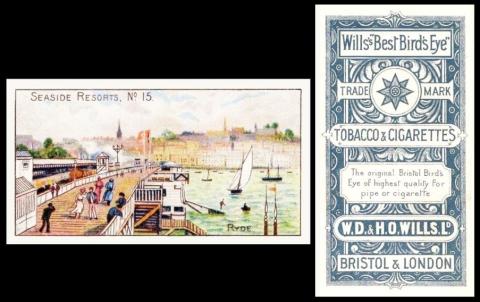
W.D. & H.O. Wills [tobacco : UK - Bristol] "Seaside Resorts" - `Best Bird`s Eye` brand (1899) 15/50 - W675-062.B : W62-44.B : W/10 [RB.3/10]
Our first trip takes us to the Isle of Wight, where today, in 1814, Ryde Pier was opened. And look, here it is on this card.
Now that date is important, because it actually makes Ryde the oldest pleasure pier in the world, and the important word in that statement is "pleasure", because traditionally you got on most ships by a plank of wood which had one end on the shore and the other on the deck, which is what a pier technically is. The difference was that a pleasure pier was walked without a purpose, or a ship to board. And later, kiosks, and entertainments, all were added, just to prolong your experience, and, perhaps, be worthy of an admittance charge being levied. But if we return to Ryde, before the pier, the trip from boat to shore was pretty ghastly. You were lucky if the tide was out, though the half a mile of sand and mud was still there, waiting to grasp at your sandals, clutch at the hem of your dress, which in those days was long and trailing. It was not a place that rich visitors came to. And with that in mind, the Ryde Pier scheme was presented to Parliament on the 24th of January, 1812. It was successful, and agreed on the 17 July, with the first meeting of a "Ryde Pier Company" just thirteen days later. The pier itself was designed by John Kent of Southampton, and it cost £12,000. And the foundation stone was levered into place on the 29th of June 1813. However the pier, entirely constructed of timber. took over a year to build, and was not finished when it was opened, on the 26th of July, 1814. It measured 576 yards, but was lengthened, gradually, to 745 yards. However in 1818 a storm struck the pier and damaged it. It was then rebuilt, and extended, on and off, until, in 1861, the idea of a tramway was mooted. However, this was built on a second pier, which opened on the 29th of August, 1864. And a third pier, for a steam railway, was opened on the 12th of July, 1880. However this was severely damaged by what is recorded as "ships being driven through it" on the 18th of January, 1881. The truth behind that is almost certainly not what you are thinking - what happened is that on the 17th and 18th of January, there was a terrible storm, snow, wind, and driving rain, and four ships were released from their bonds and swept uncontrollably into the new pier, two hundred feet of which broke free, and travelled off, with the ships, to the bottom of the sea.
Again the pier was rebuilt, and enlarged, until in 1895, a large concert pavilion was built at the pier head - at which time it was suddenly realised that maybe the wooden pier was insufficient, and the wooden supports were slowly removed and replaced with cast iron ones. In 1924 two of the piers were transferred to the ownership of Southern Railway, who actually owned the railway one already.
The pier survived two World Wars, which saw it taken over and used for military purposes and training. But in 1969 the tramway was closed. And slowly the pier fell into disrepair, with bits falling off into the sea. There was another ship-strike in the mid 1970s, after which it became a Grade II listed structure in 1976, and this has inspired several attempts at restoration. You can now walk along it, and was being considered as a cycle path but that did not happen. However, maybe one day it will become a grand tourist attraction, all over again.
The only other card I know of Ryde is simply its arms - on number 48 of Wills` "Borough Arms" (cards 1-50, in its various permutations). But does anyone know of any others?
The home page for this set is our Card of the Day for the 28th of August, 2024. That has all the details about it, extracted from our range of reference books, etc. And one day it may even have a list of which cards are known with which specific brands. However, we do know that this set can be collected with every single number showing the "Best Birds-Eye" brand, for a complete set was sold at Loddon Auctions, some years ago.
This set first appears in our original reference book to the cards of W.D. & H.O. Wills, published in 1942, as
. SEASIDE RESORTS.
. A series of fifty. Size 2-5/8 ins x 1-3/8". Numbered
. Printed by E. S. & A. Robinson, Ltd.
. Issue date, 1899Fronts printed in full colour, with frame lines. Title of set on fronts, together with number. Views titled.
Backs engraved design, printed in blue green, with six different types of advertisements : -Wills` "Best Bird`s Eye". The original Bristol Bird`s Eye of highest quality for pipe or cigarette.
These words that I have changed to bold are actually what it says on our card, in the large square. As for how it got its name, "Bird`s Eye", I know not. Though I do know that a Vanity Fair cartoon, number 575 of "Men of the Day", which shows Sir William Henry Wills, is captioned "Bird`s Eye".
By the time of our original World Tobacco Issues Index, the listing is, understandably, smaller, and reads :
- SEASIDE RESORTS. Sm. Nd. (50), Blue-grey back, engraved design. ... W62-44
B. "Gold Flake"
It is catalogued exactly the same in the updated version, save the code, which is now W675-062
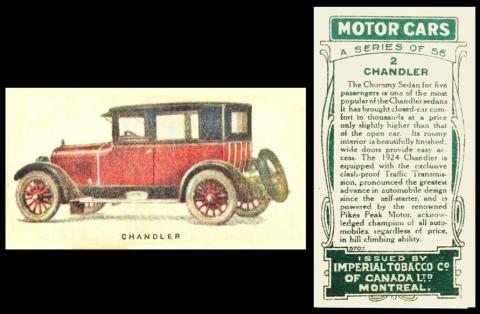
IMPERIAL Tobacco Co. of Canada Ltd. [tobacco : O/S - Montreal, Canada] "Motor Cars" (1925) 2/56 - I205-650 : I/6-28 : RB.21/339 : USA/C.20
And yes, I had better speed up for the rest!
So here we have an unusual tale and the first of this week`s centenaries, for today in 1925 saw a vehicle, like the one on this card, made by Chandler, become the first ever radio controlled car.
The radio control part was operated by a company called The Houdina Radio Control Company, which was owned by a Mr. Francis P Houdina. It was nothing to do with the Chandler company, they just selected that car, and retitled it "The American Wonder". It was also nothing to do with Harry Houdini, which was a big mistake, as he turned up at the offices and created quite a ruckus over maligning his name in such a manner. The owner of the company did issue a summons against Harry Houdini, for damage caused to the offices, but then failed to send a representative to appear for them in court, so the charges were dropped
Anyway, the radio control system worked with two cars. The Chandler had an constructed antenna on the top, and that was controlled by means of a transmitter in a second car, sending signals which made the car move in a certain direction, flash its lights, and blow its horn. And today the car had one of its trial runs, in New York, up Broadway and down Fifth Avenue. Unfortunately it did not go so well, and, after more than a few near misses, it crashed into a sedan, and the experiment was over.
They did give it a second go, still in New York City, in August, then, in October, another test took place in Boston. After that a bit of a scandal broke and it was "revealed" by disgruntled workers, that a small person was hidden in the car, working the steering. This may well have applied in the later tests, as they do seem to have worked a lot better. But then, apart from a few brief mentions in the papers of driverless cars, not attributed to any operator, the whole idea seems to have been forgotten - until it reappeared not so long ago.
This set is listed in our original World Tobacco Issues Index as :
- MOTOR CARS. Sm. 67 x 36. Nd. (56). Serial 5707. See RB.21/339. Ref. USA/C20. ... I/6-28
In the updated version it is similar :
- MOTOR CARS. Sm. 67 x 36. Nd. (56). Serial 5707. See RB.21/339. ... I205-650
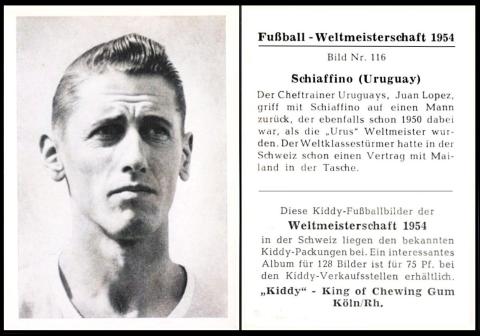
KIDDY [trade : chewing gum : O/S - Koln, Germany] "Kiddy-Fussballbilder der Weltmeisterschaft 1954" / "Kiddy Football Pictures of the World Cup 1954" (1954) 116/128?
Here we have our second centenary, for today in 1925 this man, Juan Alberto "Pepe" Schiaffino Villalba, was born, in Montevideo, Uruguay.
When he was seventeen, he joined Penarol, a team based in Montevideo. A year later, and he was already on their premier team.
He took part in both the World Cups of 1950, which Uruguay won, (and he was the second highest goal scorer of the whole tournament) - and then again in 1954, for which this set was issued. Sadly, during that event he was injured, in the semi final, and many people think that losing him contributed greatly to Uruguay not retaining the cup.
Shortly after this, he was sold to AC Milan, for a world record fee of £72,000. The injury did not hold him back, and he would help win three Championships. He also joined the Italian National Team, because his grandfather had actually been Italian, and he played with them from 1954 to 1958, in which year the Italian team went right to the final of the European Cup but lost to Real Madrid 2-3.
In 1958 he moved to another Italian team, AS Roma, and he retired in 1962.
He moved back to Uruguay, and in 1976 he started to manage his first team, Penarol. He also managed the Urugayan National Team, but only for a short while.
He died in November 2002 and is buried in Montevideo.
As far as "KIddy" the full name of the company is Kiddy Kaugummi Company MBH, of Cologne - and they issued other cards, including film star cards, and a set about the cowboy star Karl May, who was extraordinarily popular in Germany.
I am now told that there is a checklist of the set at The Football Cartophilic Exchange/Kiddy - but it is incomplete, so if anyone can help, please do

O-Pee-Chee [trade : gum : O/S - Canada] "Hockey 2010-2011" (2010) 577/600
Our third centenary regards the birth of this man, Robert Blake Theodore Lindsay, in Renfrew, Ontario, Canada - who grew up to be one of the best ice hockey players of all time, but also fought for players rights, so much so that he gained the nickname "Terrible Ted", and lost his spot on his beloved Detroit Red Wings team by being traded to the Chicago Black Hawks.
He was the youngest of nine children, and his father was a hockey goalkeeper, for the local team, the Renfrew Millionaires. In 1931 they moved, and the children were allowed to get involved in the local team there. In fact our man played his entire junior league with them.
He played hockey at college, and his talent was spotted, along with his inability to give up. In 1944, he was actually loaned out to another team, of much older players, for the Memorial Cup - and they won.
That brought him to the attention of the Detroit Red Wings, but with a hard choice, the team or college. He chose the team. And with them he would win the Stanley Cup four times.
However, in 1957 he decided that he had to fight some of the injustices in the sport, and he formed the NHL Players Association. At the time he was one of the most successful players in the world, but this mattered for little, and he was punished for standing tall, being traded to Chicago. He always believed that he was right, and in the three years he was with Chicago he thought that every day would come the reverse trade back - in fact he would not allow his family to move, they stayed in Detroit, waiting for him to come home.
When he was thirty-five, he got sick of waiting, and retired. However, four years later, the coach of the Detroit Red Wings asked him to come back and he leapt at the chance. And, with him aboard, they won the Prince of Wales Trophy and finished top of the league for the first time in many years - in fact since he left.
In 1966, he was awarded a spot in the National Hockey League Hall of fame - but did not attend the ceremony, as they would not let his family come. In 1977, he rejoined the Red Wings, as General Manager - and the team again rose up the ranks of the league tables, coming second.
After he left the team for good, he became involved with research into neurological disorders, raising millions of dollars for the cause. The Ted Lindsay Foundation is still one of the top charities in that field.
He died in March 2019, aged ninety three.
O-Pee-Chee have a long history of issuing Hockey cards, starting in 1933-34, with two sets, and issuing seven sets in total, the last in 1940-41. But their next Hockey cards did not appear until 1958 - and there is evidence that though these were branded as O-Pee-Chee they were actually produced by Topps. That is why some listings of O-Pee-Chee sets stop at 1940 and do not restart until the 1968-69 season.
After that 1968-69 season the cards continued until. There were some years when they issued additional items, posters in the 1973-74 season, stickers every season from 1981-82 until 1989-90, and transfers in 1989-90. However in 1993 the cards stopped, and did not resume until 1999. But since then there has been a set every year save 2004-05 and 2005-06.
This set, of six hundred cards, seems to have a rather strange way of doing checklists, the one for cards 1-100 appearing as card 496, then cards 497 to 500 each listing another hundred cards, up to number 500. Then card 600 contains the checklist for cards 501-600.
That is the end of the set, but there are cards numbered 601-620, which were inserted in the packets but were considered as a separate set.
There are also additional "parallel" and "insert" cards though, plus "autographed" cards, and "costume" cards - as is pretty normal these days - and, curiously, if you bought complete "Blaster" boxes the panels at the base of those boxes have pictures on them which are also considered collectable, though they are often found cut out and it does strike me that in years to come the cards on the packages, not cut off, will be the things that everyone wants.
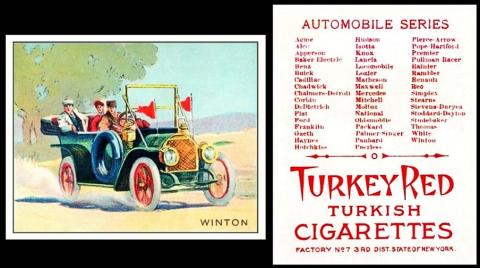
AMERICAN Tobacco [tobacco : O/S - USA] "Automobile Series" (1910) Bk/50 - A565-026 : A54-13 : USA/T.37
Now this is a curious tale indeed, because the first ever advertisement, for a motor car, to be printed in a publication was published today - in 1898.
The publication was the "Scientific American", so you might imagine that the advert spoke of the mechanical marvels and the engineering advances - but it didn`t. It starts by saying "Dispense with a horse - and save the expense, care, and anxiety of keeping it." Only then does it mention that "To run a motor-carriage costs about 1/2 cent a mile". And only then does it say the name "The Winton Motor Carriage".
I imagine that few readers will have heard of the Winton, but here we have it on a card. I was just as surprised, in fact it was the first card I tracked down for this entire edition, which is even more surprising.
The motor-carriage was made by Mr. Alexander Winton, who previously made bicycles, but was one of the many who started to tinker with adding an engine to the frame. He started his experiments in 1896, and was good at it, making one work very quickly, and then only needing to refine it. In fact by March 1897 he was only waiting for the legal paperwork to come so his new car company could get started.
His vehicles were hand made, hand painted, and luxurious to a staggering degree, with top of the range fittings, and they were fast, for the time, promising cruising rates of 30 mph, but they were not great sellers. He promoted them wildly, with many stunts, including driving one all the way from Cleveland to New York, some eight hundred miles. That was successful, but still did not sell more than a handful of cars. And so he took to advertising in the press.
Maybe it was the novelty, or just the larger, America wide, audience, but it did the trick and in 1898 the Winton Car Company expanded its facilities. Between January and December 1899 they sold over a hundred cars, an amazing total. And they added new models to the range. But by 1910, when this card was issued, their boom was over, and they merely struggled towards the First World War. They did start up again after the peace had come, but they called it a day in February 1924, and closed the factory doors, at least for the production of automobiles, for they continued to make engines, and, in 1930, were bought out by General Motors.
This set is a very attractive one, and the larger size really shows the cars off well. There is a checklist online, courtesy of Pre-War Cards, as the backs can be a bit fuzzy, and red is not always the easiest colour to read.
Several of the cards feature mention of the Vanderbilt Cup, which was a motor race for drivers all across the world, with a huge cash prize, announced by William Kissam Vanderbilt in 1904, and first held in the October of that year on Long Island, New York. The first race was beset by protests but seventeen cars still set off. And it continued to be held in New York, where a purpose built raceway was added, until 1910. After that race it moved about, until 1917, when America entered the First World War, then it stopped for the duration. However it did not restart until 1936.
By the way if you think that you have seen this card before in your travels, but in another format, you are right - the set was reprinted, in 1953, by Bowman, with strange three-dimensional backs, and retitled "Antique Autos".
Our version, the original, is catalogued in our original World Tobacco Issues Index with the American Tobacco Group Issues, first up, with the "regular" inserts. It is described as :
- AUTOMOBILE SERIES. Md. 67 x 51. Bkld. (50). "Turkey Red" brand issue. Ref. USA/T.37 ... A54-13
This is very similarly described in our updated version, as :
- AUTOMOBILE SERIES. Md. 67 x 51. Bkld. (50). "Turkey Red" brand issue. Ref. USA/T.37 ... A565-026
Now we do need to explain that the "Turkey" is nothing to do with the bird, it refers to the fact that these were Turkish cigarettes - and likewise the other A.T.C. brands, of "Turkey Land Cigarettes", and "Turkish Trophies Cigarettes". Its main claim to fame was the fact that the leaves were smaller and so more of them grew on the plant. Originally it came from Greece, but with subsequent border changes it came to be grown in the former Greek lands that became Bulgaria, Macedonia, and Turkey.
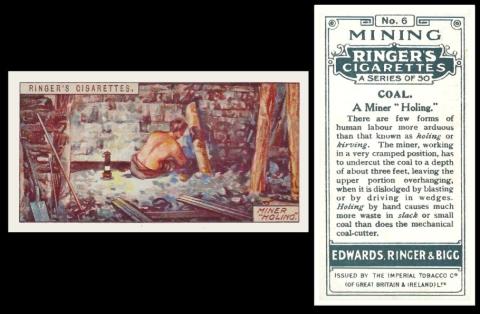
EDWARDS, Ringer & Bigg [tobacco : UK] "Mining" (1925) 6/50 - E.265-620 : E14-34
This is a rather curious set, as it is identical to one issued by Wills, but almost ten years earlier, in June 1916.
Some collectors believe that this gap was only due to the intervention of the First World War, and that this version was set up to be issued straight after the Wills one, but then was not.
However today`s diary date adds a bit of complexity, as on this day, in 1925, the same year this set was issued, the newspapers reported that at the last hour a planned national miners strike had been averted.
In fact what happened was that the government backed down to the demands of the miners, or rather to their organising body, The Miners Federation of Great Britain, and agreed to pay subsidy to the mining industry in order that miners' wages would stay the same.
One paper went even further, and renamed the day, to Red Friday. And that was the Daily Herald, a keen supporter of workers rights and the Labour Party ethos in general.
Coal mining, as it shows, on this card, was not easy work, and it was never successfully rewarded in monetary terms. Before the First World War an attempt was made to form a unifying group of underpaid trades, which would stand together in a fight. These represented the miners, transportation, and railwaymen. But the First World War came along before much was organised, so much so that in 1916 the government were able to take over the coal mining industry entirely.
After the war, it was partially handed back, but with the suggestion of nationalising it. And really that is what caused the first post-war strike, in July 1919, in Yorkshire, and the many smaller strikes after. That came to a head in April 1921, when the miners sought to have equal pay across the country. That ended badly, and they went reluctantly back to work on what is known as Black Friday, the 15th of April, 1921 - when there was a small subsidy granted them, but not enough.
Then, in 1925, sterling was re-valued, leading to mass deflation, and bad times in the coal fields, especially as far as the exporting of their product; something which was not helped by Germany, who were now capable of, and being allowed to, produce and export coal. After the war, they had been forced to give their coal mines over to France, to compensate for the damage they had caused to the French coal mines. Then, in another blow, at the end of June, The Mining Association said that any former wage agreement was no more, the wages could now be cut as and when, the national minimum was off the table, and the working hours would also have to raise.
This is when the triumvirate of unions raised up and showed its muscle, as the railwaymen agreed that they would not handle any coal during strikes. The railway companies were not so keen on this, and said any man not working would be sacked. That threatened to cause a railway strike, which would almost certainly have spread to the transport workers. So Prime Minister Stanley Baldwin stepped in and provided the subsidy which allowed for the strike, due to start on the 1st of August, to be called off.
Edwards Ringer and Bigg never had a reference book devoted to them and their issues so all that is written about this set in our original World Tobacco Issues Index is :
- MINING. Sm. Nd. (50). See H.450. ... E14-34.
And in our updated version, the text is identical, save a new card code :
- MINING. Sm. Nd. (50). See H.450. ... E265-620.
However, as this set was also issued by W.D. & H.O. Wills, you can read about their version in our newsletter for the 4th of March, 2023 (just scroll down to Sunday, 5th March). And, as they had reference books devoted entirely to their issues, we have a wealth of information on that page - and most of which applies equally to this set.
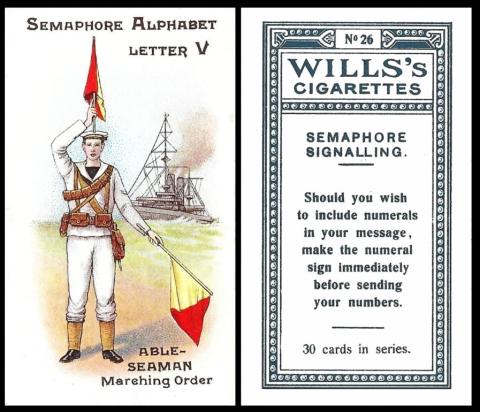
W.D. & H.O. Wills [tobacco : UK - Bristol] "Semaphore Signalling" (April 1910) 26/30 - W675-610 : W62-427 : W/324
Not many collectors seem to know of this set, though it was actually issued prior to the one we featured as our Card of the Day for the 10th of July, 2025. Part of this is because it was distributed overseas, but there is a case that the title is so similar that collectors mistake it for the other, more plentiful set.
This card follows on well from yesterday`s theme, for today, in 1925, saw the first day of the Seaman`s strike, and here we have an Able Seaman, giving the signal for Marching Orders.
The strike, though little known of today, was a big one. It started in Great Britain, when, in response to a ten per cent wage cut, sailors laid down their tools and equipment and marched off their ships. And something which must be stated here is that sailors were only paid whilst they were at sea, the moment they got into dock they were technically off duty and they received no wages.
Though the resistance here in the United Kingdom did not last too long, when the men landed in Australia, after their journey, they were steadfast in their support, got off their ships and refused to get back on. Within three weeks, British ships in Australia, New Zealand, and South Africa were all refusing to return to where they had come from, and the strikes were being joined by sailors at the other side of the world, not just Britons who had emigrated, but locals in support.
And it is could well be said that this was the true start of the General Strike, rather than Red Friday, which, coincidentally, we covered above.
The seamen in Australia stayed out the longest, even after the South Africans were back at work - and no Australians even began to return to work until November, though it was some while after that before all the men were back to work. And some men decided to stay in Australia and seek other employment rather than to go back. Often, these were the sensible ones, for on return to their home port many of the striking men were dismissed.
This set was first described in our original Wills reference book part four, as :
- 324. 30. SEMAPHORE SIGNALLING. Size 63 x 36 m/m. Fronts lithographed in colour. Backs in grey, with descriptive text. General Overseas issue between 1910 and 1915.
The month of issue was supplied in the Wills` Works Magazine, as being April 1910. This, oddly, is the very same month as "Police of the World", which was also a General Overseas Issue.
By the time we published our original World Tobacco Issues Index, the description had been much shortened. However it appears in section 5 of the Wills listing, which is for "Other Export Issues. Cards without I.T.C. Clause, issued through B.A.T.". It also tells us that the English Language Issues in section A, were "Issued chiefly in Channel Islands, Malta, India and Malaya.". The description of our set appears as :
- SEMAPHORE SIGNALLING. Sm. 63 x 36. Nd. (30). Back inscribed "Wills`s Cigarettes". ... W62-427
This is much the same in our updated version, save a new card code :
- SEMAPHORE SIGNALLING. Sm. 63 x 36. Nd. (30). Back inscribed "Wills`s Cigarettes". ... W675-610
This week's Cards of the Day...
...joined Royal Mail and celebrate the creation of the Peanuts gang - for their 75th Anniversary. Though, oddly, the first edition of the comic strip hit the newsstand on October the 2nd, 1950, and not July.
I have to say I was not sure this would be a very interesting subject, and I also thought cards would be thin on the ground, but I actually found it fascinating, and the cards came along quickly as well, not just that, but I was able to introduce a few characters that most people have forgotten!
Saturday, 19th July 2025

This card gave us "Charlie" (Hurley) and it has a "Brown" border. But I am so delighted to be able to feature it just a few days before a Topps baseball card with exactly the same border design, turned up corner and all.
Here we have Charles John Hurley, otherwise known as "King". He was born in Cork, and born in October, just like the Peanuts strip, actually on the 4th of October, 1936. Before he was a year old his family moved to England and settled in Essex. He was working as a toolmaker when he was offered a contract with West Ham, but he decided to keep working and help support his family. Then, at the age of sixteen, he had another offer, from Millwall, which he accepted. It was during this time that he was also selected for the Republic of Ireland, but, due to the Second World War, he did not play for them until 1957.
We know that he was in the Army during the war, as he injured his knee playing football for them. Millwall took him back once he was released from his war service, and he stayed there until 1957, then he joined Sunderland, which is the team shown on this card. He was there until 1969, when he joined Bolton Wanderers, for three years. Then he retired. He was given the chance to become their manager, but instead he went down and managed Reading instead. And he died on the 22nd of April 2024, aged eighty-seven.
Despite the fact that I did not know of him before this, he appears on almost thirty cards - including the A. & B.C. sets issued in 1960, 1961, 1962, 1963. 1964, and 1966. His "Rookie" card appears to be universally regarded as card 37 of Cadet Sweets` "Footballers", issued in 1958, but that too shows him in a Sunderland strip, so I wonder if he is on a Millwall card yet to be found ? If anyone has one, do please let us know.
As far as our set, we have a home page for the early A. & B.C. football cards, with our Card of the Day for the 19th of October, 2024. This describes all the sets from 1958-59 to 1967, and sorts them into date order, as well as showing all the various backs.
Today`s section of the set is described in our original British Trade Index part two as :
- A. & B.C.
Footballer Grouping (A). Md. or Lg. 9 back illustrated at Fig. ABF-10. Nd. ... ABF-10
3. Portrait or action figure with L/base corner "turned in", brown border, 81 x 57.
1. English players. Back in blue, style of Back 3, except Nos. 55, 105 (see below) and 110, which are team pictures with back headed "Footballer Check List". (110). Two subjects at No.105 - (1) Check List inscribed "English Series 2" (2) Dennis Viollet, as listed on back of No.110 which is inscribed "English Series 2 Revised".
2. Scottish Players. Back in green, style of back 4 except Nos. 44 and 81 which are team pictures with back headed "Footballer Check List" in horizontal format. (81). Backs of Nos. 44 and 81 are transposed - No.44 is a picture of Glasgow Celtic with list of Nos. 45.81 on back; No.81 is a picture of Dundee with list of Nos. 1/44 on back.
This is all changed in our updated British Trade Index, and the listing for our set reads :
ABF-10 Footballer Grouping ... AAB.310
- 3. Backs inscribed "Make a Photo". Issued 1963-4
1. English players, back in blue (110). Issued in two batches, 1/55, 56/100
2. Scottish players, back in green (81)
Sunday, 20th July 2025
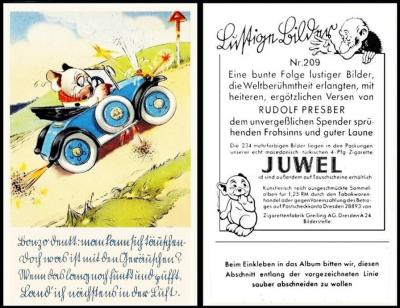
This card may be based on a cartoon dog called Bonzo, but, just like Charlie Brown`s pet pal Snoopy, he displays many human characteristics. Though here Bonzo is seen actually driving a car, whereas all Snoopy`s flights of fancy were, sadly, contained within his head.
Lets start this with the card, for though the first thing you see on it is "Juwel" that is but a brand. And if you look up "Juwel" in our original World Tobacco Issues Index you are told to see under Greiling. Once there, this set is part of a group described in as :
- LUSTIGE BILDER (Comic Pictures). Nd. ... G74-21.1
1. Series of 186. Sm. 55 x 38. (96). Lg. 74 x 51 (90). See X24/29.C
2. Series of 234. Lg. 82 x 52. Verses by Rudolf Presber.
The same link appears in our updated World Tobacco Issues Index, but there has been a bit of an addition to the text, which now reads :
- LUSTIGE BILDER (Comic Pictures). Nd. ... G800-375
1. Series of 186. Sm. 55 x 38. (96). Lg. 74 x 51 (90)
2. Series of 234. Lg. 82 x 52. Verses by Rudolf Presber. "Juwel" brand on back.
Now there seems to be more than one "Juwel" brand. Ours seems to have been from an unknown company absorbed by Greiling. Then there was reportedly another, in East Germany, made by VEB Zigarettenfabriken - but of course Dresden was in East Germany once the country was split. There is also a report that these were shorter and sold in simply cardboard boxes, but that would almost certainly reflect the fact that in those post war times there were few materials with which to make either the box or the cigarettes.
In the 1970s another "Juwel" comes along, from Eastern Europe. This was cheaper and imported to Germany, and it appears that it replaced the one made in East Germany. It did not last long, and then the brand appears again, in Germany, being made by Philip Morris.
As for Rudolf Presber, he was actually Hermann Otto Rudolf Presber, and he was born in 1868 in Frankfurt am Main, Germany. He was a writer, of all things, poetry, philosophy, plays, a true lover of words, and of education. But then he was also the son of a writer, and teacher, called Hermann Presber. Just before the turn of the twentieth century he moved to Berlin, enticed by a job, at the paper "Die Post" but also newly separated from his wife, who moved to America shortly after. He married twice more, but very little is known of these ladies. The job at "Die Post" was prestigious and he had already been involved with several papers, as a reporter and a theatre critic - but then, suddenly, in 1905 he moved to "Lustige Blatter", a satirical paper which has not dated well. It closed down in 1944, but he only worked there until he died in 1935, during surgery.
Monday, 21st July 2025

Finally we have a baseball player who Charles M. Schultz, the creator of the Peanuts comic strip, freely admitted was one of his two favourite players - the other was Willie Mays, and both these players were associated with the San Francisco Giants.
We cannot speak of Charlie Brown without speaking of baseball. He would dearly like to be a combination of the best player of all time and the best manager of the best team of all time, but unfortunately his team consists of not just his friends, but friends who are not that concerned with the sport.
We are also told that his love of the game extends to his collection of baseball cards, and, in one episode, he is desperate for a card of his idol, named as Joe Shlabotnik. Of course, one of his friends, Lucy, has just that one card, but will she swop it, no. He offers her all kinds of cards, cites the names of real players, and in the end he offers every card he owns, but she is adamant that she must keep the card he so covets. In the end, he gives up, and, walks off, and, out of his sight, she throws the card in a bin.
Joe Shlabotnik is mentioned several times throughout the life of the comic strip, but we are no closer to knowing who he was based on. We know that Charles Schultz was a fan of the San Francisco Giants, and one of his two favourite players appears in our card today. The other was Willie Mays, who we have featured before.
Willie McCovey was born on January 10, 1938, in Mobile, Alabama, the seventh child in the family, and there would be three more after him.
His first major league appearance, which was with the San Francisco Giants, came in July 1959. Later he would move, to the San Diego Padres and then the Oakland Athletics. And despite the fact that he retired in 1980, before many of today`s power hitters were born, and that he played left handed, he still appears twentieth on the all time home run records list - and if we only include the left handers, he comes second, beaten only by "Babe" Ruth.
And, coincidentally, cards 135 to 144 in this set showcase Mr. Ruth.
This set is still "Trade", because the packets, which cost five cents, included a stick of gum, five cards like the one we show today, and one "stamp" card - which seem not to be recorded anywhere, though they were definitely a trade issue.
Tuesday, 22nd July 2025
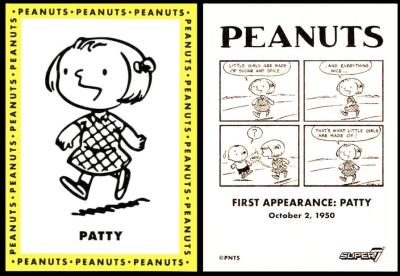
Patty appeared in the very first "Peanuts" comic strip, on October the 2nd, 1950, and, at first, she was a major character. But then she slowly slipped away, and few people even noticed.
She was first seen as part of another Charles M. Schultz comic strip, called "Li`l Folks", but she was unnamed. She then appeared in "Peanuts" in the first ever strip of October the 2nd, 1950 - but was only named as Patty on October the 26th, 1950.
Yet, in the mid 1960s, she had fallen so far from being featured that when Patricia Reichardt came along, and joined the gang, she was known as "Peppermint Patty". After that, everyone seems to have joined the two together, so much so that today, if anyone sees her, they think she is "Peppermint Patty", but she is not, she is a character all her own. And some people even believe she may have been the little red haired girl that Charlie Brown secretly loved, without ever being brave enough to admit it, let alone do anything about it.
This card was issued in 2024, as a set of twelve, and a lot of people identify it as being by Topps, though it is only branded on the cards as Super 7. After a lot of digging I found them on sale through Super 7, which is a collectables company in California. And it turns out that the cards come in wax packs, each containing five black and white cards, like ours, and a colour sticker. The twelve black and white cards can be found with a red border or a yellow one (but the central picture is the same - so technically that makes it a complete set of twenty-four), and the twelve colour sticker cards have backs that, when fitted together, make the very first colour comic strip from January 1952.
The black and white cards are :
- Baseball Charlie Brown (vertical)
- Charlie Brown (vertical)
- Linus (vertical)
- Lucy (horizontal)
- Patty (vertical)
- Pig Pen (horizontal)
- Sally (horizontal)
- Schroeder (horizontal)
- Shermy (vertical)
- Snoopy (vertical)
- Snoopy & Charlie Brown (horizontal)
- Violet (horizontal)
The colour stickers are a bit more elusive, but will be added as I find them :
- Charlie Brown - "Lets Play a Game"
Wednesday, 23rd July 2025

Here we have two characters we have already spoken of but not seen. The dog is Snoopy, a never-named breed, but, by popular definition, closely allied to a beagle - whilst the boy is Charlie Brown.
Snoopy was the fourth character to appear in the comic strip, on October the 4th, 1950, walking on all fours. But he was not called Snoopy until November the 10th, and he remained silent right until March the 16th, 1952, when suddenly his thoughts were inscribed in a bubble above his head. And he was resolute about remaining on all fours until January the 9th, 1956, when he stood up on his hind legs for the first time. Curiously, he was not stated to be Charlie Brown`s dog for some time after, that only happened on September the 1st, 1958.
The name Charlie Brown was actually part of another comic strip, "Li`l Folks", also by Charles M. Schultz, but he had no defined character. It was first used on May the 30th, 1948. Many fans believe that this strip was practise for what came later, and there was also a dog in it, called Rover, who looked much like Snoopy. Then, on October the 2nd, 1950, the "Peanuts" strip started, with a cartoon of two children sitting on a bench as another approaches, really too far away to be that visible, though the caption reads "Well ! Here comes Ol` Charlie Brown". Then he comes into view and passes. The two children on the bench were Patty, who we spoke of yesterday, and Shermy. He changed a bit over time, but first his clothing, as, on December the 21st, 1950, his plain shirt was replaced by a natty number with a zig-zag design.
The reverse of this sticker, once translated, tells us that it is one of twelve different stickers issued with "La Vache Qui Rit" - or "The Laughing Cow". However if the back is missing just look at the front of the card, because "La Vache Qui Rit" appears along the bottom frameline to the right. Up one of the sides it says "(c) [dates] - United Features Syndicate, Inc." These dates differ, see table below. Some of the pictures are also in vertical format, with a long picture. and some are in horizontal format, with a tall picture.
The characters shown, titles, and translations, in alphabetical order, rather than how they appear on the back of the sticker, are as follows :
| H/V - | colour - |
characters - |
wording - | dates |
| H - | blue - | Snoopy, Lucy - |
"Avec un sourire ca va mieux / it feels better with a smile - |
1952 - 1958 |
| V - | blue - | Snoopy, Woodstock - | "C`est bon d`avoir un copain" / it`s good to have a friend - |
1958 - 1965 |
| H - | yellow - | Patty, Snoopy - |
"Dites-le avec des fleurs" / say it with flowers - |
1950 -1958 |
| V - | blue & green - | Snoopy - | "Et vive la peche a la ligne" / and long live fishing - |
1958 |
| V - | yellow - | Snoopy, skateboard - | "Et vive le sport" / and long live sport - |
1958 |
| V - | yellow, pink - | Snoopy - | "J`en fais toujours trop" / I always do too much - |
1958 |
| H - | pink, green - | Snoopy - | "Je suis en pleine forme" / I am in good shape - |
1958 |
| V - | orange | Snoopy, Charlie Brown - | "L`homme est le meilleur ami du chien" / man is a dog`s best friend |
1950 -1958 |
| V - | yellow - | Snoopy - | "Moi, j`aime les espaces verts" / I like green spaces - |
1958 |
| V - | yellow - | Snoopy - | "Moi, j`prefere la marche a pied!" / I prefer walking - |
1965 |
| V - | pink, yellow | Snoopy - | "On devrait construire les villes a la campagne" / we should build cities in the countryside |
1958 |
| H - | green | Snoopy, Woodstock - | "Un toit pour chacun" / a roof for everyone |
1958 - 1965 |
Thursday, 24th July 2025
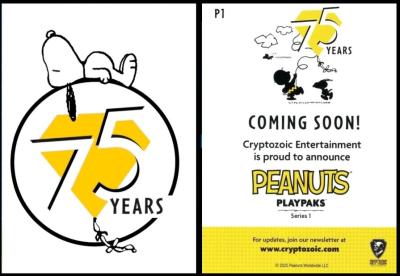
Now before I race ahead, how cool is the above header - for we actually have not only a date of issue, with a day, but this card advertises a set which is not actually yet released.
But how wonderfully it ties in with this week`s theme, which is all about the 75th Anniversary of the Peanuts strip cartoons.
Cryptozoic Entertainment retail a range of collectibles, not just cards, and they specialise in popular culture. Their links are pretty impressive, including with DC Comics. And they have a website, which I have been checking out to help me write this - that link will take you to the announcement of this set, but the site is well worth exploring. They also stall out at various film and card shows, and it was at one of these, the San Diego Comic-Con, that this card was given away - and they talk of that release on a blog page of their website. In fact it is through that page that we know this is the only promo card, for it says "..and an exclusive promo card..." If it had been one of many, such would have been mentioned.
This set is multi-faceted, and there is more than a base set - you get foil cards, stickers, scented cards. and tattoos (of a temporary nature). But there is something which, for me, harks back to olden times, because some of the cards fold so that the background goes away and the character is free standing, just like those birds eggs from Ogden et al - or the footballers from the early boys` magazines... And I think that is rather fun.
Anyway our character today is again Snoopy, but it is the "75" that we celebrate more than that. And I wonder if Charles M. Schultz ever dreamed that his little family of characters would still be so popular, that long after he sat and doodled them....
Friday, 25th July 2025
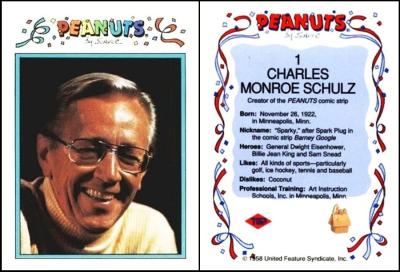
This set is sometimes referred to as "Peanuts Preview" but this really only applied to the promo card, which is entitled "A Celebration Preview Prototype".
This card has a bit of a surprise, as it is one of the few places where you will find out that the "M" in Charles M. Schultz stands for "Monroe".
The rest of the set consists of cards of the major characters, these being Charlie Brown, Franklin, Linus, Lucy, Marcie, Peppermint Patty, Pigpen, Sally Brown, Schroeder, Snoopy, Spike, and Woodstock. Lucy actually appears again, in her psychiatric booth, rather than allot the space to another character. And so does Linus, waiting for the Great Pumpkin.
Then there are cards of Snoopy and his activities, most of which he does but in his dreams - basketball, camping, enjoying Easter, fighting the Red Baron, golf, ice hockey, in space, kissing Lucy, posing in his sunglasses as "Joe Cool", pretending to be a vulture, tennis, winning Gold at the Olympic Games, and writing the Great American Novel.
The final cards deal with a facet of the Peanuts world that Mr. Schultz probably never imagined, its moving from a flat cartoon to stage and screen and into popular culture. So card 26 speaks of "You`re a Good Man, Charlie Brown", a stage musical which opened off Broadway and traversed the world - as well as being successfully screened on television. Card 27 reminds us that a book, called "Happiness is a Warm Puppy" (which is totally true in my world) was the first ever cartoon character book to make the New York Times best seller list. Card 31 shows the first ever Peanuts feature film, "A Boy Named Charlie Brown". Card 32 tells of the 1973 Thanksgiving Special, which won an Emmy. And Card 33 features their first ever Christmas Special TV programme.
There is a rather magical, kind of parallel, set associated with this, as Mr. Schultz signed every card in one of the sets, and it was then scattered to the winds amongst the distribution chain, with true pot luck as to where it fell.
time beat me, but only just, and I will add the gen from the reference books over the weekend.
If anyone has a better card of a Chandler car, or knows about Kiddy chewing gum, please get in touch with webmaster@card-world.co.uk - and if any of our subjects spark memories do let us know, we love hearing from you all....
Have great weekend, and week, and I will be back again next week with more delights!
